Col. Sudhir Farm

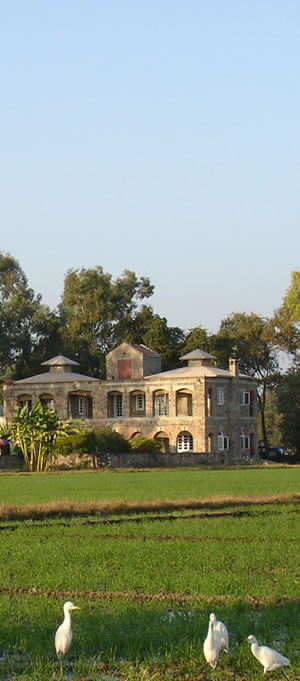


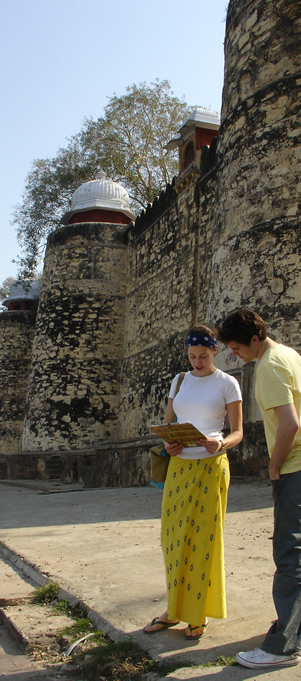

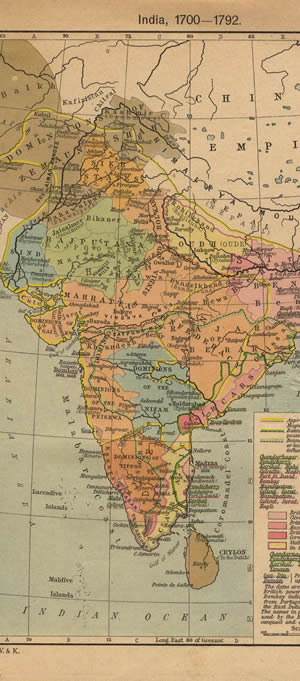
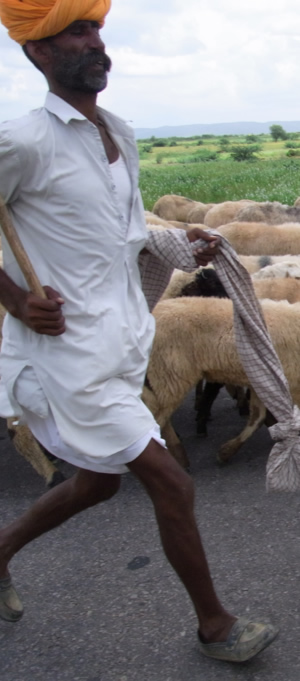
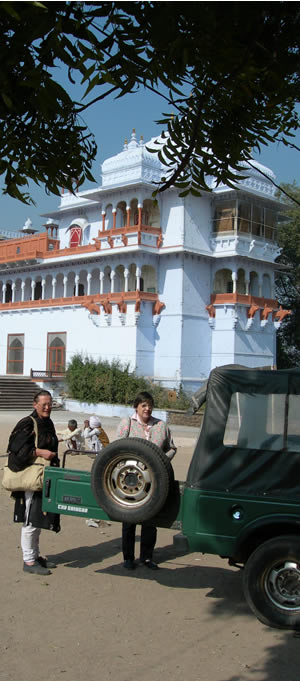
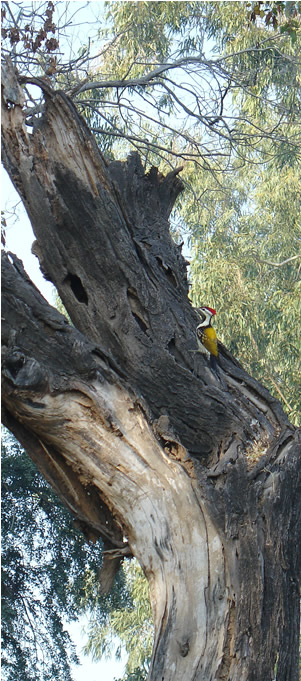
Snippets from the Visitors' Book
The Kota tonga trail was a real highlight - a bit like a 19th Century treasure hunt. It’s full of little nuggets of unusual information and fascinating glimpses into the unsolved mysteries of Kota.
Harriet and Will, London. UK
The memorial to Major Burton and his sons was much more moving than the Taj Mahal or the lake at Udaipur, marvellous as they are.
Henry Vane, Cumbria, UK
...the most comfortable bed I’ve slept in for 2 months....
Charlotte Adam, Winchester UK
Two days out of the noise and the people in a beautiful place. We felt totally
at home
- To be recommended to every person who wishes to experience the Indian country life. We also liked the way the food was prepared...
Patrick & Marie-Christine Lemaigre, Nil-St Vincent, Belgium
We’re only here for the porridge and home made bread! Thank you for a most wonderful time the memories of which we shall carry always. You have given us a wonderful & fascinating introduction to India.
Sue Turner, Lancashire, UK
So ...Rajasthan is not all desert! Thank you for sharing everything with us....
The Read family, London, UK
What a wonderful time we’ve had at the school in the village, at the weavers’, on the river, atop a tonga! Thank you for all your help and contacts throughout India
Anne Gerbner, Philadelphia, USA
It was a wonderful stay and thank you for giving us such a positive look at India and Rajasthan.
Salma Goldstein, New Jersey, USA
- There once was a lady of Kota
- Who took visitors out in her motor
- With the roads and the ruts
- It took quite some guts
- To go out with the lady of Kota.
- But once back at home on the farm
- The world quite descended to calm
- With the plants and the birds
- And fox terriers in herds
- There was balm in the calm on the farm.
Sue Millar, London, UK
After travelling around Rajasthan for two weeks, reaching a real house with books on the shelves, photos on the walls and four happy dogs was simply wonderful.
Camille Savinien, Paris, France
This isn’t tourism. I know of nowhere else where you can experience the real India as well as on your traditional working Rajasthani farm.
Sam Milward, Wellington, New Zealand
Thank you so very much for such a wonderful stay - what a fantastic introduction to India. I don’t think we’ll find such tranquillity elsewhere.
Lizzie Fortune, Hampshire. UK
Fabulous - I’ve been spoilt. It’s hard to leave and face the real world.
Elisabeth Simson, Isle of Wight, UK
After travelling around Rajasthan for two weeks, reaching a real house with books on the shelves, photos on the walls and four happy dogs was simply wonderful.
Camille Savinien, Paris, France
This isn’t tourism. I know of nowhere else where you can experience the real India as well as on your traditional working Rajasthani farm.
Sam Milward, Wellington, New Zealand
Thank you so very much for such a wonderful stay - what a fantastic introduction to India. I don’t think we’ll find such tranquillity elsewhere.
Lizzie Fortune, Hampshire. UK
Our visit at the farm was truly wonderful, off the beaten track it is a slice of India a visitor does not normally experience. Victoria is very knowledgeable about Indian culture and the people - an added perspective for us. The food here was very delicious: organically home grown ingredients, vegetables, fruits, grains prepared simply homestyle. A nice change from curries. Enjoyed the early morning boat ride and walk to the weavers. Many thanks.
Johanna Janssens, Washington, USA
I loved staying with you and the dogs and playing with the toys.
Jonas aged 8, Switzerland
A very welcome break from the crazy world of India – wonderful house, food and hospitality. Thank you so much.
Katie Buxton, Bath, UK
I loved seeing the crocodiles, and I learned a lot about deticking the puppies. Coming to the farm was a great experience.
Stella Bartholet, Washington, USA
A wonderful eye opening visit in every sense. We will be back! Thank you!
Christopher & Joanna Hobson, Northamptonshire, UK
A blissfully peaceful stay. We enjoyed everything – even the power cut. Thank you for lovely food, good company and very interesting trips.
Vicky Stark, London, UK
Exactly what we hoped for and more, bits of India off the tourist track, life as it actually is in villages, teeming life and livestock and the magic of the river.
Sir Hilary Miller, Worcester, UK
Thank you for the introduction to miniature painters, wall paintings, stories, great food, good company, walk through the fields. I loved the paintings in the City Palace and go back full of inspiration and memories.
Nan Mulder, Edinburgh, UK

On the Farm - 2011 Archive
On the Farm - December ’11
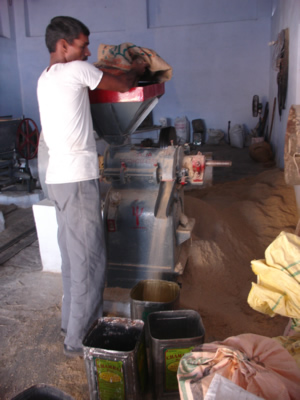 We kept some rice back for home consumption and here you can see the local rice mill where small quantities of rice can be taken for dehusking and sieving. From 100 kgs. one gets about 40 kgs. of rice grain.
We kept some rice back for home consumption and here you can see the local rice mill where small quantities of rice can be taken for dehusking and sieving. From 100 kgs. one gets about 40 kgs. of rice grain.
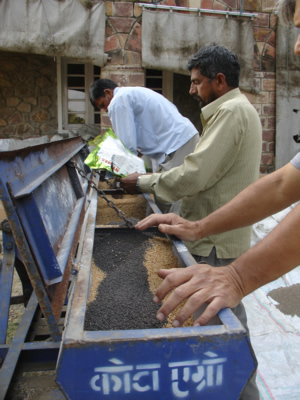 December is the month in which the wheat is sown and the mustard watered. This year, as an experiment, we planted a small amount of a traditional variety of wheat which requires less water and fertiliser, and has a better flavour but lower yield. There is no commercial market for it and whatever wheat we get has to be sold privately.
December is the month in which the wheat is sown and the mustard watered. This year, as an experiment, we planted a small amount of a traditional variety of wheat which requires less water and fertiliser, and has a better flavour but lower yield. There is no commercial market for it and whatever wheat we get has to be sold privately.
Here the seed is being mixed with a fertiliser with the trade name Hyumus which claims to be an organic fertiliser made from seaweed and humic acid. We planted half with conventional fertiliser called DAP (di-ammonium phosphate) reduced to half its normal dosage, and the other half with Hyumus. The seed was bought at the newly opened seed bank at the Government run Agricultural Research Station next door which currently stocks twenty-two varieties of wheat and plans to stock fifty.
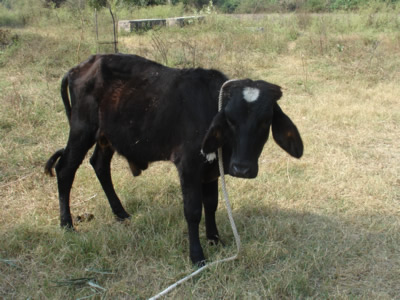 This is Vijay’s Christmas present. Diamond has been abandoned as being worthless i.e. a male improved-breed calf. He has been adopted by us and we will look after him in return for his dung!
This is Vijay’s Christmas present. Diamond has been abandoned as being worthless i.e. a male improved-breed calf. He has been adopted by us and we will look after him in return for his dung!
On the Farm - November ’11
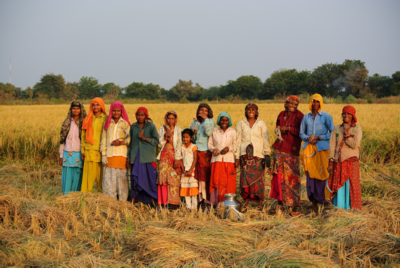 Straight after the soyabean harvest the same team of women went onto cutting our rice. They refused the Rs. 600 per bigha offered for the soyabean cutting and demanded (and got!) Rs. 700. Last year the rate was Rs. 550. Last year petrol cost Rs. 50/litre. This month it has gone up to Rs. 72. Taxes make up 46% of the retail price. Pakistan and the USA sell it for Rs. 42/litre and Bangladesh for Rs. 45. Relative to incomes, petrol in India is the most expensive in the world.
Straight after the soyabean harvest the same team of women went onto cutting our rice. They refused the Rs. 600 per bigha offered for the soyabean cutting and demanded (and got!) Rs. 700. Last year the rate was Rs. 550. Last year petrol cost Rs. 50/litre. This month it has gone up to Rs. 72. Taxes make up 46% of the retail price. Pakistan and the USA sell it for Rs. 42/litre and Bangladesh for Rs. 45. Relative to incomes, petrol in India is the most expensive in the world.
On the Farm - October ’11
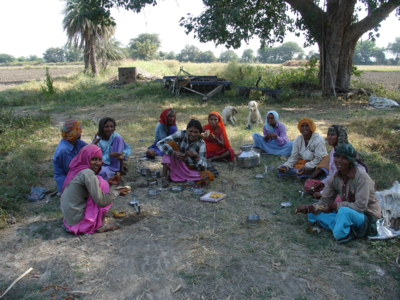 We missed being on the farm in October as we were in England for our son’s wedding. On our return we gave ‘laddus’ made from chickpea flour, ghee and sugar to all who work on our farm including these women pictured in their lunch break from piling high the dry soyabean bundles you can see in the background ready for threshing. A kilogram of these ‘laddus’ cost Rs. 140, which is a day's wages for agricultural workers.
We missed being on the farm in October as we were in England for our son’s wedding. On our return we gave ‘laddus’ made from chickpea flour, ghee and sugar to all who work on our farm including these women pictured in their lunch break from piling high the dry soyabean bundles you can see in the background ready for threshing. A kilogram of these ‘laddus’ cost Rs. 140, which is a day's wages for agricultural workers.
During October as the land gradually dried out and the tall bamboo-like ‘dhaincha’ (sesbania cannabina) had to be hand-cut before being ploughed in, the greatest sadness was the loss of all three tiny calves in the space of three days. We will never know why they succumbed so close together and to what.
We harvested all 35 bighas of soyabean having intended to plough most in as green manure. Because of the heavy rains it had outgrown the weeds and the yield was good.
On the Farm - September ’11
 Rain, rain and more rain. The three dogs spent many hours lying on their beds and watching the rain or sleeping. (The yellow on Anjelica’s back - the dog in the middle - is turmeric, an attempt to deter numerous ticks which had to be removed daily.)
Rain, rain and more rain. The three dogs spent many hours lying on their beds and watching the rain or sleeping. (The yellow on Anjelica’s back - the dog in the middle - is turmeric, an attempt to deter numerous ticks which had to be removed daily.)
 The tall jungle of dhaincha (Sasbania cannabina) was planted in June with the intention of ploughing it in for green manure. The field has been waterlogged since, preventing ploughing by tractor. It has now developed fibrous stems which would clog the thresher if we tried to extract the seeds, and will not rot in the ground as manure if we plough it in when the field dries sufficiently. The shorter plants in the foreground have been eaten by the cows. Had we let the cows graze in the field freely the whole field would have been more manageable.
The tall jungle of dhaincha (Sasbania cannabina) was planted in June with the intention of ploughing it in for green manure. The field has been waterlogged since, preventing ploughing by tractor. It has now developed fibrous stems which would clog the thresher if we tried to extract the seeds, and will not rot in the ground as manure if we plough it in when the field dries sufficiently. The shorter plants in the foreground have been eaten by the cows. Had we let the cows graze in the field freely the whole field would have been more manageable.
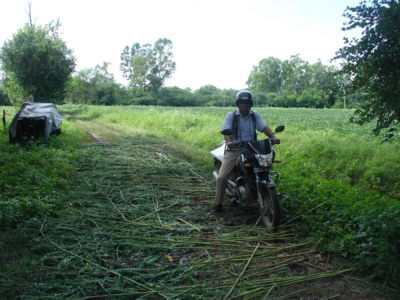 We have invented one use for it however. By spreading it on our track we are using it to prevent the jeep and the motorbike slipping in the mud and making even deeper ruts.
We have invented one use for it however. By spreading it on our track we are using it to prevent the jeep and the motorbike slipping in the mud and making even deeper ruts.
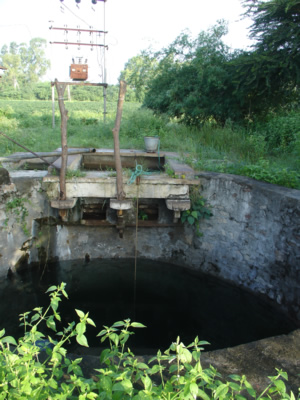 The rain finally stopped but here is how high the water level in the well was by the end of September, the highest for several years.
The rain finally stopped but here is how high the water level in the well was by the end of September, the highest for several years.

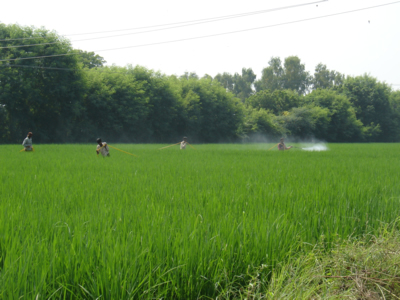
We very reluctantly allowed Garsilal to spray his rice and here he is proudly displaying his new tractor mounted spraying equipment.
Four people carried the spraying hosepipe through the fields splashing through ankle deep water and fine silt. They wear no face masks or protective clothing. The nozzle is aimed at each plant individually to kill the stem borers.
On the Farm - August ’11
 We are the only farm around here which is not spraying soyabean with herbicide and so the women are glad to have some weeding work. Here the two lines of women are in separate fields.
We are the only farm around here which is not spraying soyabean with herbicide and so the women are glad to have some weeding work. Here the two lines of women are in separate fields.
On the Farm - July ’11
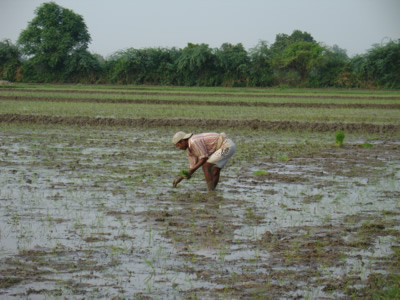 Because of the good rain in June, the Bihari rice specialists reappeared this year. A team of seven male workers transplanted the rice quickly and efficiently and then went back to Bihar.
Because of the good rain in June, the Bihari rice specialists reappeared this year. A team of seven male workers transplanted the rice quickly and efficiently and then went back to Bihar.
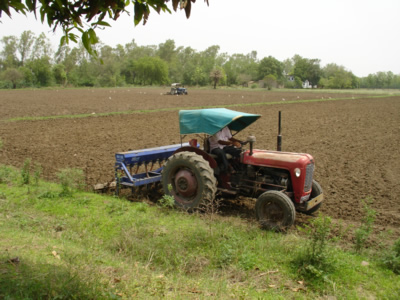 After June’s heavy rain we were able to sow soyabean. The tractor in the foreground is sowing in one field and the tractor in the background is levelling the soil in preparation for sowing.
After June’s heavy rain we were able to sow soyabean. The tractor in the foreground is sowing in one field and the tractor in the background is levelling the soil in preparation for sowing.
 We waited until we needed water to flood the paddy fields before installing the new transformer. The Electricity Board ‘engineer’ stood on the ground and gave instructions to our farm workers on how to wire it up.
We waited until we needed water to flood the paddy fields before installing the new transformer. The Electricity Board ‘engineer’ stood on the ground and gave instructions to our farm workers on how to wire it up.
Here you can see the sign Vijay has put up in warning and examples of the standards of wiring!
On the Farm - June ’11

 After the stubble burning, the farm looks like this but fresh green shoots appear within a few days. Summer high winds caused two trees to fall this month, both killed by termites. If you look carefully at the break you can see the jagged remains of the soft wood after the depredation of white ants.
After the stubble burning, the farm looks like this but fresh green shoots appear within a few days. Summer high winds caused two trees to fall this month, both killed by termites. If you look carefully at the break you can see the jagged remains of the soft wood after the depredation of white ants.
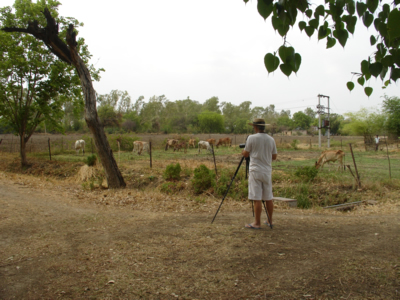 Here Vijay is observing a woodpecker before the other tree fell. The cows are enjoying the grass in the vegetable patch before it was ploughed in. We can't grow vegetable in the summer as nilgai jump over the fence and eat them.
Here Vijay is observing a woodpecker before the other tree fell. The cows are enjoying the grass in the vegetable patch before it was ploughed in. We can't grow vegetable in the summer as nilgai jump over the fence and eat them.
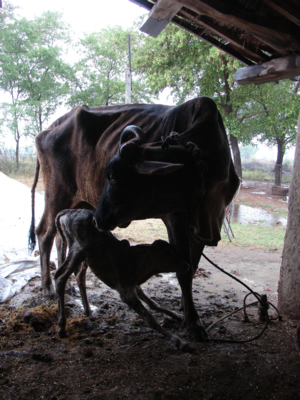 From 45oC-26oC in one month. Here the third of our three calves born this month struggles to get up half-an-hour after birth. Her mother, Mun-Mun, with the single horn, is now 17. The photo illustrates the bleakness of the monsoon. There is flooding in the background after an unprecedented three days of rain in the last week of June.
From 45oC-26oC in one month. Here the third of our three calves born this month struggles to get up half-an-hour after birth. Her mother, Mun-Mun, with the single horn, is now 17. The photo illustrates the bleakness of the monsoon. There is flooding in the background after an unprecedented three days of rain in the last week of June.
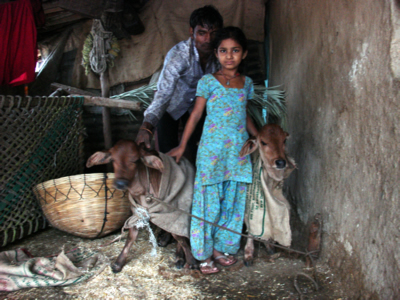
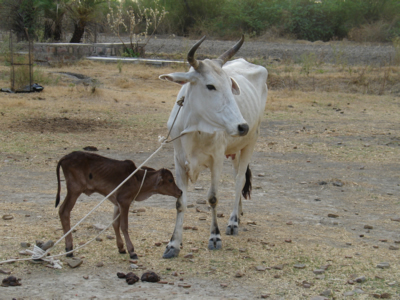 Here are Chanchal and Dashrath in their designer sacks sheltering from the rain. And a photograph of white Raimi with her calf Dashrath.
Here are Chanchal and Dashrath in their designer sacks sheltering from the rain. And a photograph of white Raimi with her calf Dashrath.
On the Farm - May ’11
 Despite being hot (45oC on a few days), May is a colourful month. The bright red gulmohar tree contrasts with the golden stubble. Here Anjelica is keeping a wary eye on the stubble burning. The magnificient neem tree in this field smouldered inside its trunk for two days before we realised it had caught fire. We hope it will survive.
Despite being hot (45oC on a few days), May is a colourful month. The bright red gulmohar tree contrasts with the golden stubble. Here Anjelica is keeping a wary eye on the stubble burning. The magnificient neem tree in this field smouldered inside its trunk for two days before we realised it had caught fire. We hope it will survive.
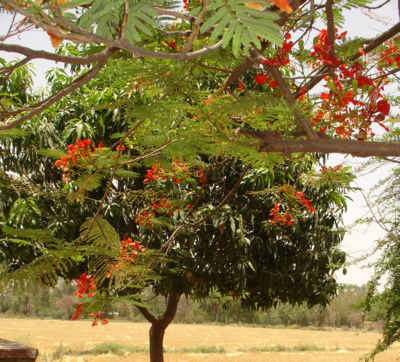 One of the delights of May are green mangoes. This year for the first summer since Vijay’s mother died 12 years ago, the mango tree planted to mark her cremation site was dripping in them. You can see it here behind the gulmohar. Without a 24-hour guard no fruit will ripen, so we picked early and enjoyed green mango chutney and puddings. The golden stubble of our wheat forms the backdrop to this picture.
One of the delights of May are green mangoes. This year for the first summer since Vijay’s mother died 12 years ago, the mango tree planted to mark her cremation site was dripping in them. You can see it here behind the gulmohar. Without a 24-hour guard no fruit will ripen, so we picked early and enjoyed green mango chutney and puddings. The golden stubble of our wheat forms the backdrop to this picture.
The bhousa (chaff) took four men three nine-hour nights to load by the basketful into a tractor trailer and then tip-up near the cows. Wages have increased by 10 percent this year and the cost of keeping a dairy has soared. This may well be our last year of keeping our own cows!
On the Farm - April ’11
 With the coriander (dhania) and mustard (sarson) harvested, it was the turn of wheat in April. The same team that cut the coriander moved in two lines cutting as they went, leaving bundles of wheat in two straight lines. Two team members followed behind, tying the bundles with soaked wheat stalks. The harvesters are paid in wheat and this year their rate has increased from 50 kgs. per bigha of land to 60 kgs. which comes to about 11% of the total yield. The man who owns and operates the stationary thresher takes one bag for every 12 produced. The rate for combine harvesting has increased by 50% this year to Rs.400/bigha of land, which is about 5% of yield but with no bhoussa/chaff to sell for fodder. Because of a bumper harvest this year, the sale price has stagnated and our first lot went for below the government support price Rs. 1120 per quintal (100 kgs.).
With the coriander (dhania) and mustard (sarson) harvested, it was the turn of wheat in April. The same team that cut the coriander moved in two lines cutting as they went, leaving bundles of wheat in two straight lines. Two team members followed behind, tying the bundles with soaked wheat stalks. The harvesters are paid in wheat and this year their rate has increased from 50 kgs. per bigha of land to 60 kgs. which comes to about 11% of the total yield. The man who owns and operates the stationary thresher takes one bag for every 12 produced. The rate for combine harvesting has increased by 50% this year to Rs.400/bigha of land, which is about 5% of yield but with no bhoussa/chaff to sell for fodder. Because of a bumper harvest this year, the sale price has stagnated and our first lot went for below the government support price Rs. 1120 per quintal (100 kgs.).
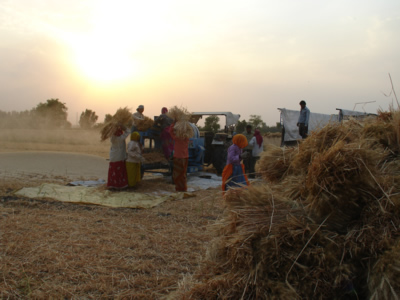
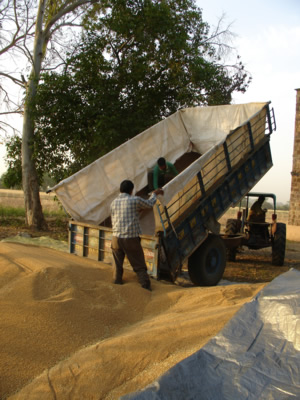 On April 2nd, the women started cutting, on 12th they piled the bundles into 4 big heaps and at 1800 hrs. started threshing. Their men folk came to relieve them while they took turns sleeping in the fields. The 15 bighas of wheat were finally finished at 0600 hrs. Here the trailer is being unloaded in the early morning sun.
On April 2nd, the women started cutting, on 12th they piled the bundles into 4 big heaps and at 1800 hrs. started threshing. Their men folk came to relieve them while they took turns sleeping in the fields. The 15 bighas of wheat were finally finished at 0600 hrs. Here the trailer is being unloaded in the early morning sun.
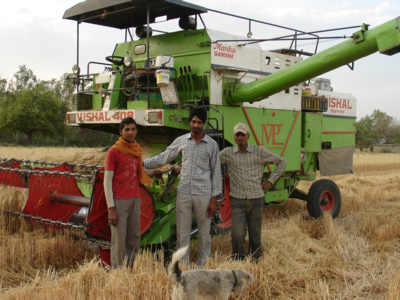 Another 59.5 bighas of wheat went under the rotating blades of the combine harvester and these guys plus another three worked non-stop till the lot was done between 1300 hrs. and 2115 hrs. Then they sat down to a takeaway dinner in our fields and left all their rubbish for us to clear the following morning.
Another 59.5 bighas of wheat went under the rotating blades of the combine harvester and these guys plus another three worked non-stop till the lot was done between 1300 hrs. and 2115 hrs. Then they sat down to a takeaway dinner in our fields and left all their rubbish for us to clear the following morning.
On the Farm - March ’11
 We needed a new transformer for the third watering of the wheat and had to collect and instal it ourselves; it was heavy. The man from the electricity company came and wired it. The meter is inside the transformer case. For some reason, the electricity board is using meters that only change readings on the first of each month. We have had to buy and wire our own meter to monitor daily usage.
We needed a new transformer for the third watering of the wheat and had to collect and instal it ourselves; it was heavy. The man from the electricity company came and wired it. The meter is inside the transformer case. For some reason, the electricity board is using meters that only change readings on the first of each month. We have had to buy and wire our own meter to monitor daily usage.
 From March 10th we started harvesting the crops. This peaceful scene is endangered: wages have increased by 30% in one year and commodity prices have barely moved, inspite of the increase in food prices at the shops. Coriander is in the foreground. A separate team of 7 women is cutting mustard in the background.
From March 10th we started harvesting the crops. This peaceful scene is endangered: wages have increased by 30% in one year and commodity prices have barely moved, inspite of the increase in food prices at the shops. Coriander is in the foreground. A separate team of 7 women is cutting mustard in the background.
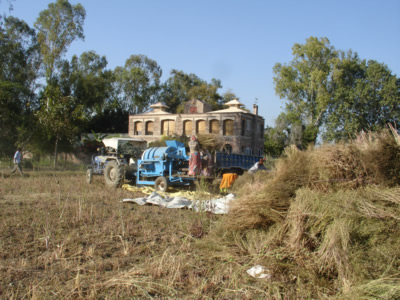 On March 15th the nine women came back to pile-up and then thresh the coriander. After threshing it was winnowed in front of a strong fan to blow away remaining chaff. It was left to dry until after Holi on March 20th, then quickly bagged and sent to the market on 21st with the mustard.
On March 15th the nine women came back to pile-up and then thresh the coriander. After threshing it was winnowed in front of a strong fan to blow away remaining chaff. It was left to dry until after Holi on March 20th, then quickly bagged and sent to the market on 21st with the mustard.
The mustard had been threshed by a different team of women in a very hot strong wind. With cloths around their faces they had struggled on for eight hours. To add to their woes they had had little sleep the previous night as the whole are was without electricity for 12 hours. The buzzing of mosquitoes, in the absence of fans, is enough to keep any one from sleep.
 That same night, Vijay suspecting foul play when the electricity had been off for some hours, went out at 4 a.m. (19 March) to check and found that our brand new transformer had been trashed. Expert thieves had tripped the mains 11Kv line, cut the wires, unbolted the transformer from the frame and dropped it to the ground, dismantled the transformer on the ground and made off with a goodly weight in copper wire (the core and winding weighed 119 kgs.). Copper prices are really high. Here is Australian guest Peter Witton surveying the damage.
That same night, Vijay suspecting foul play when the electricity had been off for some hours, went out at 4 a.m. (19 March) to check and found that our brand new transformer had been trashed. Expert thieves had tripped the mains 11Kv line, cut the wires, unbolted the transformer from the frame and dropped it to the ground, dismantled the transformer on the ground and made off with a goodly weight in copper wire (the core and winding weighed 119 kgs.). Copper prices are really high. Here is Australian guest Peter Witton surveying the damage.
The linesman came at 0930 hrs. to render the wires safe and power was restored at 1000 hrs. Luckily, we had finished watering the wheat and will not need water again till July. It is up to the electricity department to file an FIR (first incident report) with the police and for them to investigate. By end of the month the police had still not been. No wonder, if you need a replacement transformer quickly, you are advised to say it is broken rather than stolen, hmmm....
On the Farm - February ’11
February is a month of watering the crops from the tubewells and watching them grow.
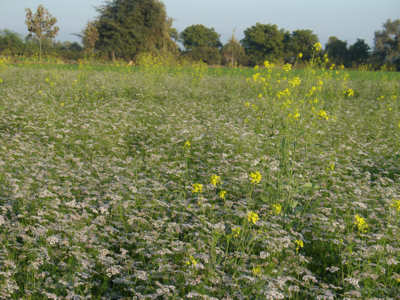 This is what coriander looks like when flowering. The yellow plants are rogue mustard.
This is what coriander looks like when flowering. The yellow plants are rogue mustard.
 The black specks encrusting this high-yield variety of mustard are aphids. Perhaps Monsanto was expecting us to buy expensive pesticide? We did not spray and enjoyed watching the birds feasting.
The black specks encrusting this high-yield variety of mustard are aphids. Perhaps Monsanto was expecting us to buy expensive pesticide? We did not spray and enjoyed watching the birds feasting.
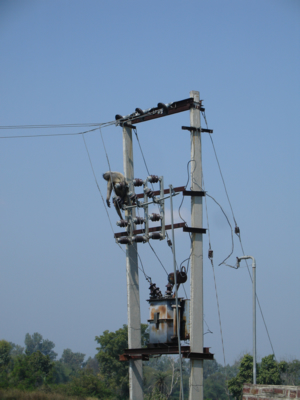 A sad episode in February was the electrocution of this langur monkey. It climbed the pole and got stuck to the high voltage wires. It transpired later that someone may have tried to steal the transformer, but could not, and left the whole transformer box live (check out the central porcelain wire connection to the box leaning to the left). We were lucky, and very fortunate, that none of us touched the metal while reading the meter on the transformer box! The local electricity company has no standards of workmanship and quality inspectors in our parts as it seems, as they leave wires in a state that would not be acceptable in any technologically advanced economy.
A sad episode in February was the electrocution of this langur monkey. It climbed the pole and got stuck to the high voltage wires. It transpired later that someone may have tried to steal the transformer, but could not, and left the whole transformer box live (check out the central porcelain wire connection to the box leaning to the left). We were lucky, and very fortunate, that none of us touched the metal while reading the meter on the transformer box! The local electricity company has no standards of workmanship and quality inspectors in our parts as it seems, as they leave wires in a state that would not be acceptable in any technologically advanced economy.
On the Farm - January ’11
 A month of pig damage. The brown patches are pig damage to our field of coriander (dhania).
A month of pig damage. The brown patches are pig damage to our field of coriander (dhania).
 This is pig damage to Tigger. On January 17th he was chasing a large wild boar (along with other dogs) and came off the worse. He had a hole in his upper left lip and a long and deep slit to this right thigh, narrowly missing the artery. Despite ingenious home made head collars and muzzles, the stitches had to be redone four times.
This is pig damage to Tigger. On January 17th he was chasing a large wild boar (along with other dogs) and came off the worse. He had a hole in his upper left lip and a long and deep slit to this right thigh, narrowly missing the artery. Despite ingenious home made head collars and muzzles, the stitches had to be redone four times.
 January 14th is makkar shankranti, which marks the day when the sun appears to start moving northwards. It is celebrated with kite-flying in north India and this year little Dashrath tried his hand.
January 14th is makkar shankranti, which marks the day when the sun appears to start moving northwards. It is celebrated with kite-flying in north India and this year little Dashrath tried his hand.
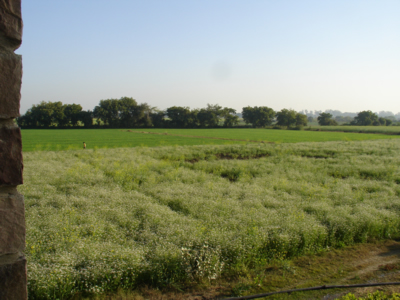 By the end of the month the coriander was in full flower. Bagdi Ram, in the distance, is moving black plastic pipes (as visible in the foreground) to water the wheat fields which are beyond the coriander field. All watering is being done from the tube wells. The wheat is being watered for the second time; one more to go.
By the end of the month the coriander was in full flower. Bagdi Ram, in the distance, is moving black plastic pipes (as visible in the foreground) to water the wheat fields which are beyond the coriander field. All watering is being done from the tube wells. The wheat is being watered for the second time; one more to go.
Ranjeet took down his satellite dish as the rats had chewed through the wires. One of the two cows in milk collapsed unexpectedly at midnight and died within half-an-hour. A case of undetected bloat perhaps from eating took much green bersin? Two steps forward, one step back.

